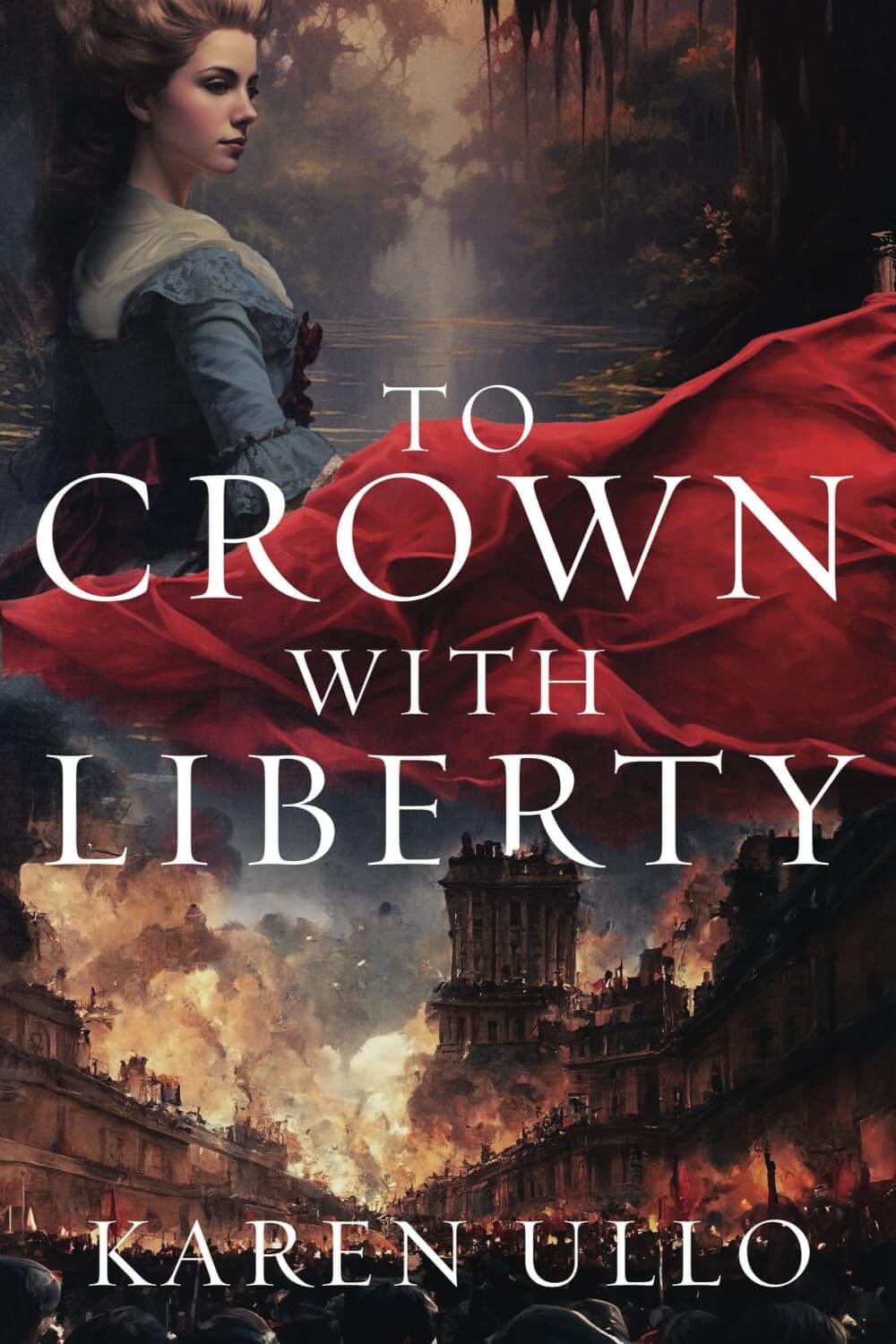Reviewed by
Every historical novel is part documentary and part fairytale. This is particularly true of To Crown with Liberty, which splits its time, and its timeline, between Paris in the dying days of the Ancien Régime and the wilds of Louisiana where its characters take refuge after the revolution. It may seem odd to cast Paris and the palace of Versailles in the role of the mundane world, but that is what they are to Alix de Morainville, and Ullo, whose two previous books, Cinder Allia and Jennifer the Damned, are both, in the broad sense, fairy tales, does an excellent job of casting it as the mundane element of Alix’s story. The wilds of Louisiana are, by contrast, a fairyland to her. And just as the mundane world is the site of political drama and fairyland the site of moral drama, so it is for Alix de Morainville, and for this novel.
Alix is not the typical historical fiction heroine. In fairytale fashion, she is born a noblewoman but is raised by kindly fishermen. Her musical talent makes her, by the age of 17, a favorite of Marie Antoinette. She is as improbable a creature as any fairytale character, and her marriage to her milk-brother, who is also her gardener, is truly the stuff of fairytales.
But if she is too much a fairytale creation to call her a woman of her time, she is certainly not the kind of modern woman in fancy dress that one finds in most historical novels today. She is not found on the barricades screaming, “Liberté.” Nor is she picking up a musket to defend the palace. She is, for the most part, an observer, though one given to occasional romantic and impractical, almost fairytale, gestures. As Alix herself says in the narrative, “Rarely was there any way I could be useful either within my own household or to the greater events taking place outside its walls. My lot was to watch the forces of history unfold, armed with no weapon but prayer.”
Constancy is the virtue she clings to as she watches those forces unfold. But she struggles to understand how to live out that constancy in a world falling apart. It is welcome to see such as she, and not the stereotypical “strong female lead” so frequently and so tediously trotted out in almost every oeuvre in the genre. For this alone To Crown with Liberty deserves to be distinguished from the ordinary run of historical fiction.
However, the effect of this long period of watching and waiting as the French Revolution unfolds around her, and Alix’s web of loves and friendships is laid out, is that the main drama of the book is postponed until the last fifty or so pages, and the reader must until then pass the time with Alix’s account of the unfolding revolution, full of encounters and conversations with many of the prominent figures of the revolution.
This is where the documentary side of the story comes to the fore. Alix dines with Talleyrand and has tea with Patsy Jefferson. Dr. Guillotin, inventor of the eponymous means of execution, is her gynecologist. It is a fine work of historical voyeurism, and if ever I thought I might have caught Ullo in an anachronism, research proved her to be correct every time. Historical fiction fans can have a fine game of celebrity spotting in this part of the book, and Ullo’s historical notes provide a comprehensive list of major and minor figures mentioned so you can check off your finds. While it is perhaps a somewhat sanitized version of the Ancien Régime, most readers will, I think, be happy not to have their noses rubbed in the debauchery of the court.
Alix’s inability to affect the tragedy playing out around her is actually the key to the theme of the book, which is our responsibilities in the face of an evil we have no power to resist. The poignancy of Alix’s dilemma, and the seriousness of the moral issue it raises are some compensation for sticking with her through the years in which she is more observer than actor.
In fairytale fashion, however, the complexities of politics are subsumed in the imperatives of personal loyalty, and the simplicity of high moral certainties. Whether or not we today would think Alix’s loyalties are rightly placed, it is the intensity of those loyalties and the moral consequences of betraying them that is central to the drama of the book. Alix’s self-accusation, her sense of sin, her seeking for repentance and forgiveness are the emotional and dramatic core of the story. I found the reconciliation scenes with Matthieu and with Madelaine particularly affecting.
For me, though, the way that the documentary and fairytale elements of the novel are blended leaves something to be desired. The exposition of the Louisiana-based chapters contains spoilers for the Paris-based scenes, robbing them of an element of their drama, and I could have wished for a narrator who could have shown us the experiences of those characters more directly involved in the events of the day. I would have preferred more Louisiana and less Paris, and to have had Alix’s moral dilemma introduced earlier.
Nonetheless, there is something here for both the fan of on-the-scene historical fiction, and for the fan of the high moral drama of a fairytale. If you feel affection for the somewhat pathetic but good-hearted Alix as her life follows its pre-determined course and the revolution starts to boil up around her, you will be happy enough with the first part. And if you love a good moral fairytale, you should be pleased with the conclusion.
A secondary theme deserves some mention as well. Alix’s meetings with Thomas Jefferson, Patsy Jefferson, and Sally Hemings, and her personal feelings about slavery, frame an implicit reflection on the contrast between a revolution that respected religious liberty and one that did not, and between one that abolished slavery and one that did not. While her characters are French, it seems to me that To Crown with Liberty is also asking questions about what it means to be American. The symbolism of a Comtesse married to her gardener escaping violence in the old world and landing in New Orleans, albeit a Spanish possession at the time, cannot be ignored.
Catholics will find in Alix’s story a reminder of the full and dreadful fidelity to which we are called, without any sort of hagiographic whitewashing. Alix may be a fairytale woman, but she is no plaster saint. Secular readers may perhaps balk at her religiosity, and her particular crisis of conscience may seem to them less serious than Alix takes it to be. It is, nonetheless, one I think they should take seriously. It is, after all, the question that every ordinary citizen of a corrupt government has to face: do I stand against a force I cannot possibly resist, or face the wall and let the tumbrils roll by? It is a question we may all be asked to face before our lives are over. To Crown with Liberty should leave you with that question to ponder.



